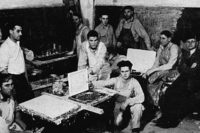The last 85 years have seen some dramatic shifts in the wall and ceiling industry. In 1938, lath and plaster were king of interior finishing for walls and ceilings. Even with metal lath already being invented, wood lath was the predominant lath used throughout the ’30s and ’40s for interior plaster. Drywall was invented in 1894. However, it was “rock lath,” the father of drywall, which first grabbed significant market share by replacing wood lath. This gypsum-based lath was soon the rage as the housing economy heated up after World War II.
Interior Plaster Was King
In 1938, interior plastering was so popular in America that manufacturers had successfully overcome the need for lime pits with double-hydrated lime and developed many pre-blended finish coats. Even basecoat gypsum, known as “hard wall,” was a mainstay for three decades. I can remember, as a young boy, being paid to scrape interior hard wall plaster in preparation for the base coat of finish, or “putty,” coat. In the middle of the century, gypsum plastering was so popular and widespread that manufacturers had to formulate various interior finish gauging plasters and limes to meet specific regional preferences.
It was the 1960s when the plastering industry saw drywall encroach and take over the market. Plastering instituted the “knock on the wall” campaign to persuade homebuyers to stay with plaster, but it was to no avail. The final attempt was the thin wall or veneer plaster systems. These were skim coats of plaster applied to drywall panels with special face papers. The concept was to speed installation and be competitive with drywall, and still provide a hard durable finish coat.
Plaster’s Downfall
Eventually, plaster lost its interior market share. It was not catastrophic, as cement plaster (stucco) was still a popular exterior cladding and could be applied only by plasterers. The invention of the plaster pump, or “Tommy gun,” in the 1960s ensured stucco would not suffer the same fate as interior plaster. These massive pumps improved production rates to lower the cost of installed cement stucco, making it harder for other claddings to take this market share. The exterior insulation and finishing system was introduced to America and quickly grabbed significant commercial market share by being innovative and energy-efficient. By 1990, EIFS had been so successful in commercial markets that they decided it was time to aggressively pursue the residential market. They miscalculated residential industry cladding practices and, due to installation errors, suffered greatly.
Similar to interior plaster, EIFS lost significant market share in less than 10 years’ time. This was a tough time for EIFS, and the black eye it suffered during those years was not deserved. EIFS was, and still is, an excellent cladding for energy efficiency.
By the late 1970s, interior gypsum plaster was all but dead. However, cement plaster was continuing to keep its market share, even if the number of lathers and plasterers was reduced. Consider that the Los Angeles Union local for plasterers once had over 2,000 plasterers. Fifteen years later, even with a wider geographical reach, they went down to just under 300 plasterers. What happened?
Lathing Trouble
The great construction recession of 1980 saw most lathers leave the industry. Lathers were the ones who best understood flashing, particularly for windows. The early 1980s was a time when a pent-up demand for homes developed and set us up for the boom that was coming. The boom produced a need for workers, but most were untrained and had little to no idea how to flash a basic window. Contractors were pressed to perform and could not stop to train people. After only a few years, the leaks started to appear all over America and Canada. The term “leaky condo” became all too familiar. There was lots of finger pointing to go around; buildings were now too airtight, we stopped using overhangs, and there were too many holes in the building paper and insufficient drainage for drying of walls. A new profession of “building science” came into being. They solved the problem with elaborate fixes, new product lines and more restrictive codes to curb the issue of water intrusion. Most were well intended but too often ignored the history of why this happened—or worse—tried to rewrite history.
Exterior lath and plaster are still alive, even if they have been bruised a bit. Owners still want plaster, interior and exterior, and they will even pay a slight premium for it. However, there is also a tipping point where they will just say no thanks. That is where the industry needs to stay sharp and focused.
Look to the Future
Therefore, when people say the wall and ceiling business is a dinosaur industry that refuses to change, I reply, “You don’t really know our industry, do you?” We have adapted and will continue to adapt, invent and find a way to survive the next 85 years.
Happy 85th Anniversary to Walls & Ceilings!





Report Abusive Comment